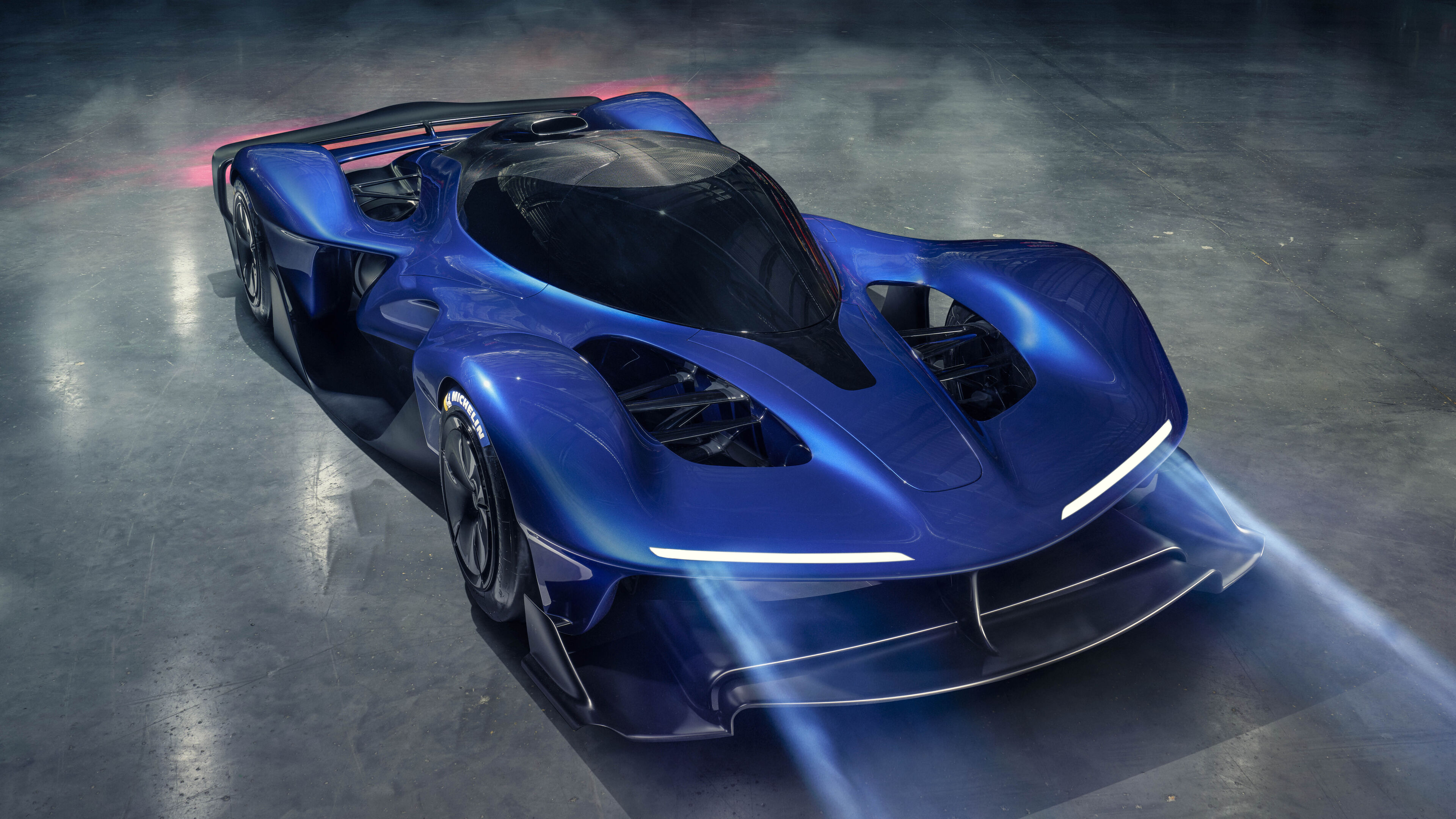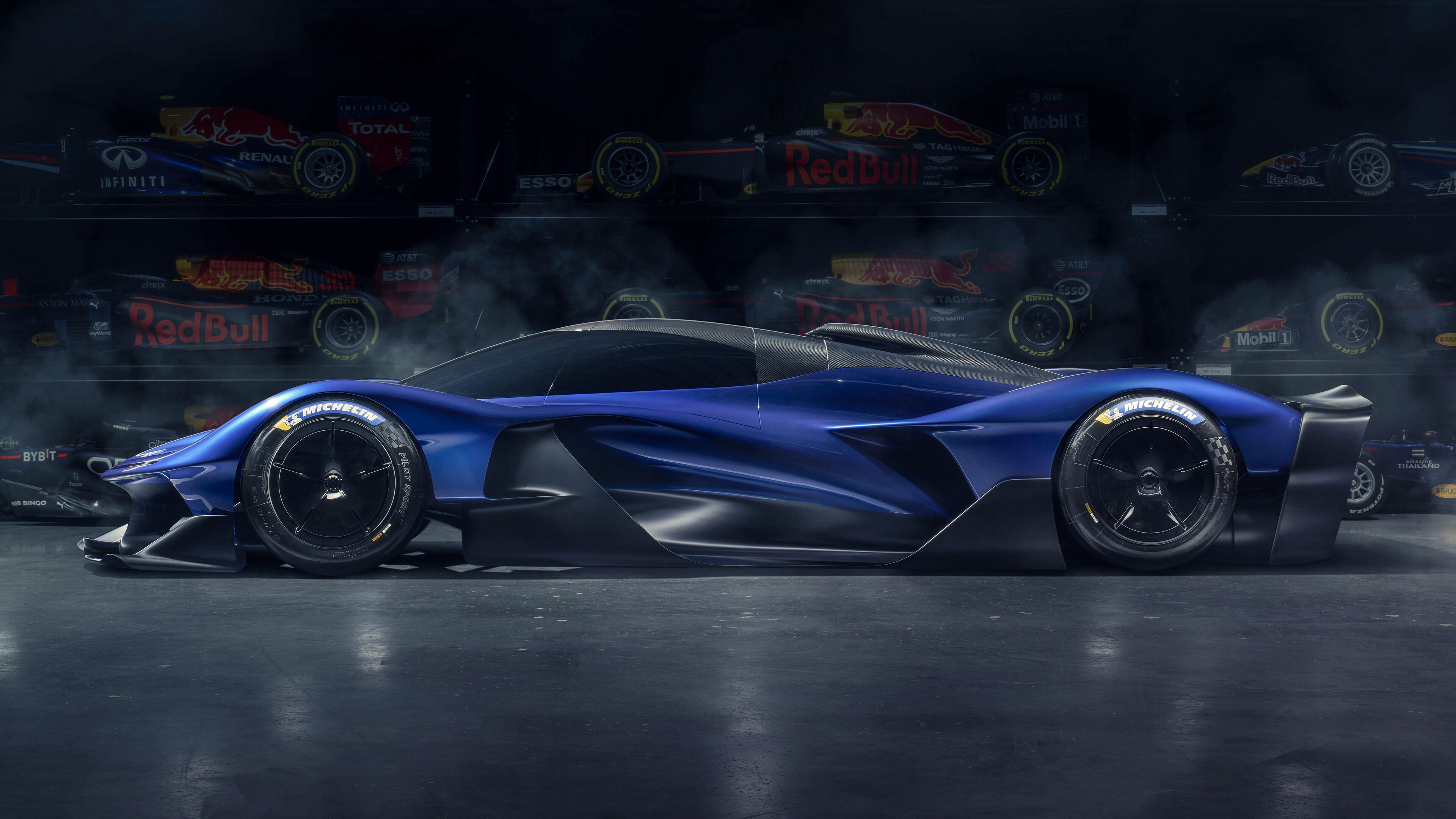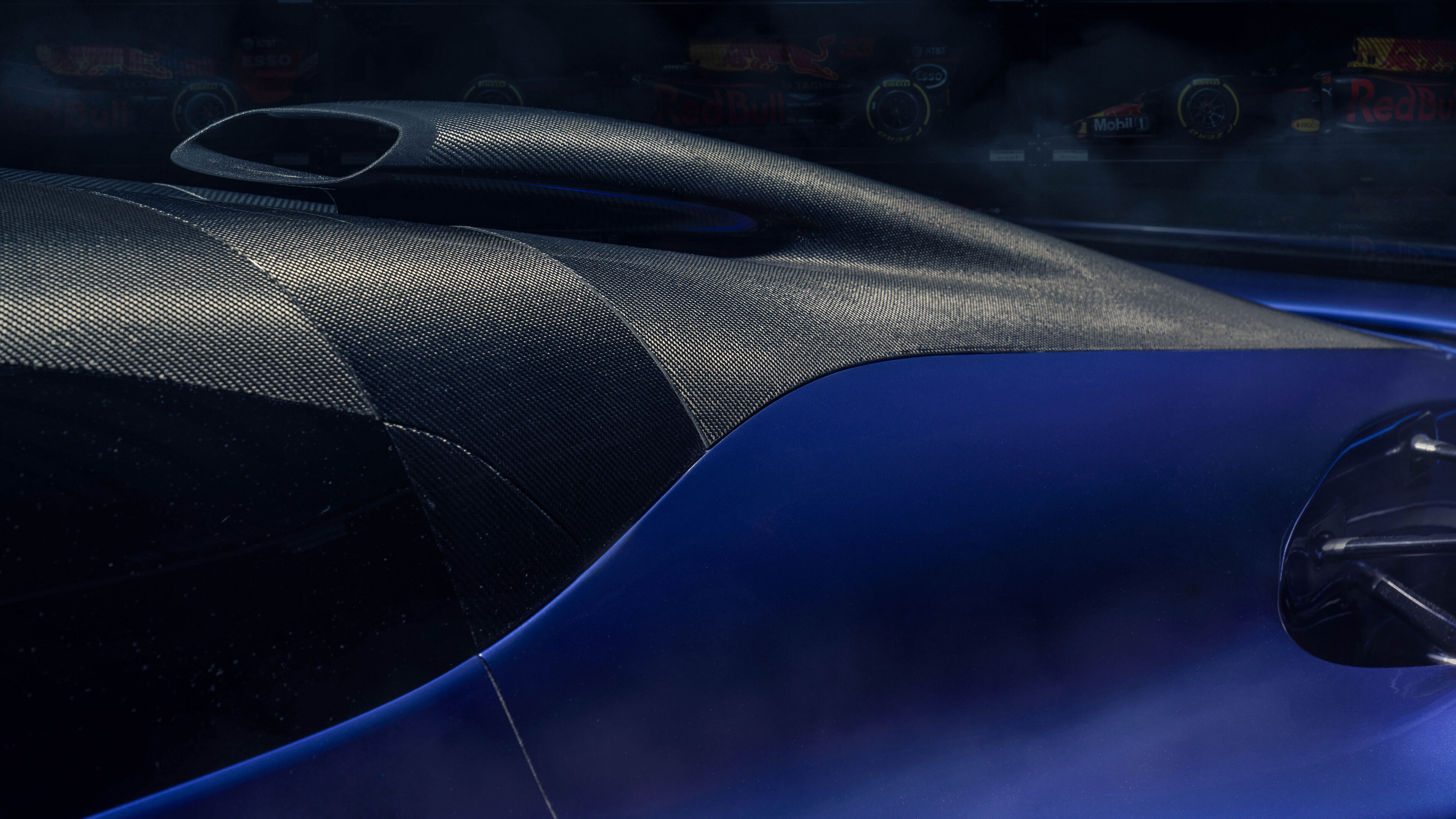
Newey on the RB17: "if you get in half asleep it has the potential to bite"
A car designed to deliver F1 lap times... while being usable for mere mortals. The fabled RB17 is nearly ready...
The RB17 is the fabled creature that has occupied Adrian Newey’s thoughts since 2020, but whose origins lie much further back. Way back. Neither a road car nor a competition machine, it’s a track only hypercar that marshals almost everything Newey has learned in his 40+ year career, a maximal motor car conceived without constraint, other than self-imposed ones. It’s powered by a Red Bull spec, Cosworth made 1,000bhp 4.5-litre V10 that can rev to 15,000rpm, in a car with an overall target weight of 875kg. And it has an e-motor.
First impressions? It looks big and surprisingly long, a spaceship of a thing. It’s mesmerising in detail and execution, and there’s a clear visual through line to a contemporary F1 car. Imagine a cockpit on a recent Red Bull and you’re halfway there. Its side pods are sensational – hell, it’s a non-competition car that actually has side pods. It’s also a shape that’s defined more by what’s missing than what’s actually there.
Porosity, they call it, and there are whole sections of the RB17 that invite intimate hands on investigation. Visualise the turbulent air around the front wheel arches being tidied up, before being redirected under the car and into a tunnel of stunning complexity. There are two fans in there somewhere, too, transforming all this energised air into aero magic. Look, too, at the full width rear wing that’s there primarily to extract the air from the diffuser. The name? When Covid-19 pressed the giant pause button, Red Bull never ran an F1 car called RB17. Now the badge has a home.
Photography: John Wycherley
Form invariably follows function on a car like this, and the similarity to the Aston Martin Valkyrie is undeniable. That, of course, was another Newey project, a Red Bull led collaboration that sundered when Aston went its own way in F1 under new owner Lawrence Stroll. Estranged from one of its parents, the Valkyrie impressed mightily but felt unfinished in some areas. It was also compromised because it was chasing downforce and mega lap times while also having to be road legal.
The RB17’s track focus dodges that particular bullet. This is an Adrian Newey designed car that will deliver F1 lap times and outrageous levels of driver engagement around the world’s great crucibles of speed – Silverstone, Spa and Suzuka. Red Bull’s Advanced Technologies division is fast growing, but it’s not a car manufacturer. So this is a steep learning curve, even for these guys. F1 teams don’t exactly churn out cars, and consider that Red Bull Racing has made fewer than 100 chassis in its 20 year history.
Remember the Red Bull X1, the car Newey designed for Gran Turismo 5 and 6, back in 2010? There was more to it than perhaps we thought. “It was a fantasy car,” Newey explains. “It didn’t have any CFD [computational fluid dynamics] or internal work. It was a first sketch that got turned into a styling model for a computer game. But it had the basic thought behind it, and it’s been gently ticking away in the back of my mind since then.”
The real thing moved centre stage mentally in Christmas 2019. During a ski break, and frustrated by the lack of decent snow, Newey began drawing a hypercar. For a man whose successes have been measured by one primary criteria – the stopwatch – you might be surprised by the principles he laid down for what would become the RB17. “It’s my belief that cars at this level should be something you can treat as a piece of art or sculpture,” he explains.
“My career has always been performance oriented, so when it comes to aerodynamics you always go with what makes the car faster. With this we wanted it to be a more rounded product in terms of the look, sound and the driving experience. The intent is the most important thing to start with. And that was to create a car that was capable of F1 lap times but at the same time be accessible to people – two people at that.
“I do track days from time to time and it’s nice to be able to give passenger rides. With this car you’ve got proper visibility, and the passenger seat is slightly staggered. Makes sense to do it that way and it’s an elegant solution. The wider cabin has weight and aerodynamic implications, but it was a penalty I felt we should take. There’s luggage space at the front, space for two sets of overalls, and room for a pair of helmets behind you.”
Whoever gets to experience it will have much to enjoy, though they might need to work on their neck muscles and resting heart rate. The RB17 really is a mildly civilised F1 car, better in some key respects, in fact. The chassis is made of carbon composite, as you’d expect. The car also uses active suspension, banned in F1 since 1994, but core to the RB17’s amazing bandwidth because it offers such precise control over the vehicle dynamics.
“You need a platform the active systems can work against,” explains RBAT boss Rob Gray. “We ran a lot of simulations to determine the minimal stiffness that still gave a good response on the active suspension system. We did find there’s a point where it falls off a cliff. We’re definitely ahead of that point. We could have made the car stiffer but it wouldn’t have gone any faster. We got to a level that gave us the handling characteristics we wanted, beyond which extra stiffness just meant excess weight.”
Top Gear
Newsletter
Thank you for subscribing to our newsletter. Look out for your regular round-up of news, reviews and offers in your inbox.
Get all the latest news, reviews and exclusives, direct to your inbox.
Safety is also a vital component. The RB17 takes its cues here from LMH regulations, in terms of structural integrity but also in what’s called the ‘overturning moment’. In essence, it shouldn’t suffer from such an acute degree of lift in the event of an accident or impact that it becomes fully airborne (see YouTube for examples of endurance racing cars doing this). The team has managed to comply with these restrictions without destroying the styling. Newey is passionate that the RB17 looks beautiful, for all that it’s aero driven.
“On the parts of the F1 car I’ve drawn, and that’s by no means all of it these days, part of the aesthetic brain does kick in, maybe even subconsciously,” he says. “Very often the aerodynamically efficient form is also aesthetically pleasing. The Spitfire wasn’t drawn for styling, or Concorde, but they were two of the prettiest aircraft that have ever been built.”
The process here is compelling. Newey drew the aerodynamic surfaces, as ever by hand, which were transferred into CFD in order to visualise the air flow and understand the loads that were being generated. At that point, Red Bull hired a couple of RCA automotive design graduates to flesh out the surfaces, before submitting their proposals for more CFD analysis. If downforce points were lost during the styling process, the aero guys could suggest ways of recovering them. These loops would continue until everyone was happy, an iterative process that would obviously never happen in F1.
So the RB17 really is a sculpture. No doubt there are wealthy people out there who would buy one purely for static display, but what a waste that would be. Question is, how do you make something capable of delivering contemporary F1 lap times accessible to mere mortals? The active suspension is key here, as is a graduated traction control system and a range of chassis modes. Their parameters are still being configured, but Newey is clearly chuffed that active suspension is back in play.
“It allows you to change the mechanical balance and your stability margin,” he explains. “Combined with the car’s active aero surfaces it allows you to change the centre of pressure [the ratio of front downforce versus rear downforce], which is quite far forwards in any case. And we will have knobs in the cockpit that allow you to do that on the fly, so you can have more stability on the entry to a low speed corner or more stability at the apex of a high speed one... it gives us tremendous flexibility.”
The RB17 is targeting 1,700kg of downforce at 150mph, and the floor is doing more of the work than on an F1 car because... no rules. And what of the tyres, perhaps the limiting factor when it comes to such vast aero forces? Red Bull is working with Michelin on three different compounds. The most extreme tyre is the ‘confidential’, which is a bit peaky but offers huge grip. The standard slick serves up more slip angle and is less temperature sensitive, and there will also be a treaded option. On the subject of slip angles, you’re looking in the wrong place if it’s powersliding you’re after. “Absolutely not,” Newey says firmly. “I do not want to see any photos with all that going on. I know that’s what you love but it leaves me cold. It’s just showboating, isn’t it?”
Not that the man who races a Ford GT40 and Lotus 49B in historic events is averse to a car moving around a bit beneath the driver. “That’s why we’re offering all these different modes and tyre solutions. I wouldn’t suggest [the RB17] is the first car that you ever drive on a racetrack, but if you turn out to have a lot of drive and determination, then you can get to extreme levels of performance. It has that adaptability.”
The gearbox is designed and assembled in house, although the gears themselves are made by Xtrac. Shift times will be fast, though not as fast as the instant shift setup in an F1 car, to avoid excessive harshness. The e-motor takes care of first and reverse, and makes low speed manoeuvring a doddle, as well as adding 200bhp and torque filling when required.
In a similar vein, lessons have been learned from the painfully loud Valkyrie, so the V10 is a semi-stressed member rather than being bolted directly to the chassis. Compliantly mounting the engine added weight but it was a price worth paying. The RB17 also has to meet the noise regulations of as many circuits as possible, and should be hitting no more than 105db. The exhaust is a 10 into one setup, inspired by the Newey designed 2000 McLaren MP4/15, a car he cites as the best sounding F1 car of all. Its steering is fully hydraulic, and very similar to an F1 car’s, in that it uses a mechanical spring to sense the amount of torque the driver is putting in, before opening a hydraulic valve to feed fluid either way.
If you get in with that tingle of adrenalin and nervousness, I think that’s part of the excitement
“An F1 car is 12–18 months in development before it goes to the first test,” Newey says. “Work on the RB17 started in Christmas 2020 and we’ve been in the concept phase for three years or more. That’s allowed us to really quiz it, be self critical, be careful on the direction we’ve taken, go off on a route, evaluate it, not be happy and change to another.”
It’s not something they usually have the luxury of doing, and the upshot is that you’re looking at pretty much the third generation of the car before the first one has even appeared. “It’s had three different engines, it started off being all-wheel drive, with the e-motor on the front axle rather than the rear, until our simulations showed it was better to be rear drive, once you’re free of a weight limit. I was happy about that. Rear drive is easier to manage,” Newey says, before confirming the car you see here is still not fully signed off. He will tweak until the last possible moment.
Work on the interior is ongoing, although the seating configuration was frozen early on. “That was all part of the basic package. The available structural space is now fixed, and we’re working on the ergonomics, where we put the screens and switchgear. The interior is an important factor. We don’t want it to be a spartan racecar cabin. Physical buttons, definitely, especially on a car with this level of performance. You need a physical knob you can change. Then there will be interior options.” Massage seats? “The car does that,” Newey says, without missing a beat. (We were joking.)
The powertrain will be on the dyno any day now, with development work gathering pace throughout the rest of the year. All the sub systems will have been proven out before coming together in the first few test cars, ahead of a track debut in summer 2025. Production is limited to 50 cars, all of which will be made at Red Bull’s ever expanding technology campus near Milton Keynes. The manufacturing processes mirror those of an F1 car, another thing that underpins the RB17’s unique selling proposition. The car will cost £5m.
It enters a wild and weird part of the automotive world. Ferrari’s XX programme is now well established, and the Prancing Horse recently added the 499P Modificata for rich mortals to play with alongside its F1 Corse Clienti programme. You could always get your jollies by buying an old racing car, or sign up for one of the many high end single make racing series. But the RB17 exists in its own space, a clean sheet design from one of the masters of the motorsport universe, pushing the boundaries once again. “This is the next level, several levels to be honest, on from [the Valkyrie] in terms of its performance. Yes, of course if you get in half asleep and not focused it has the potential to bite. If you get in with that tingle of adrenalin and nervousness, I think that’s part of the excitement.”
Trending this week
- Car Review
BMW iX3











